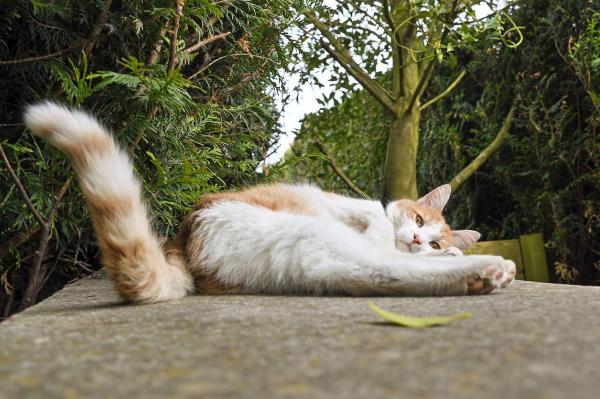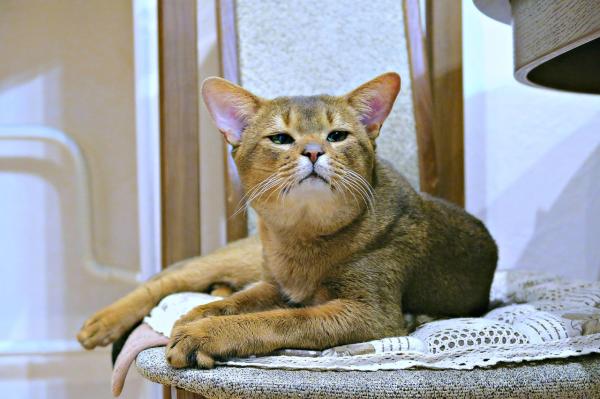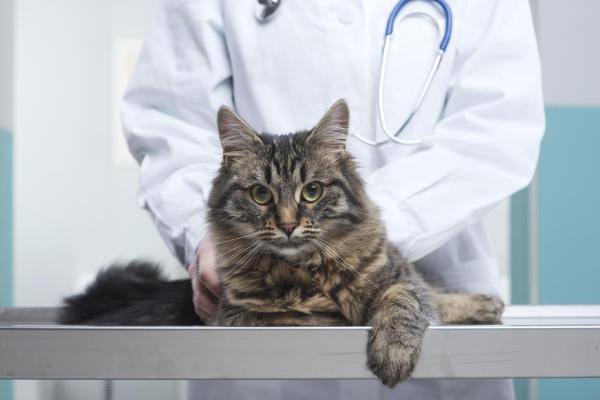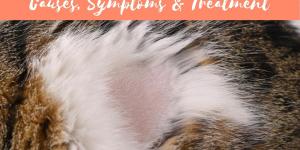Hyperesthesia in Cats - Causes and Treatment



See files for Cats
Cats are very hygienic animals who will spend a large portion of their day grooming themselves. There are many reasons for this behavior. Maintaining a healthy coat helps to protect them from the elements, prevent parasite infestation and even eases anxiety. Although cats can spend much of their day dedicated to this activity, it is spread out and not compulsive. For cats with feline hyperesthesia syndrome (FHS), this grooming is intense and prolonged. The results can be detrimental to the health of your cat.
At AnimalWised, we find out what to expect with hyperesthesia in cats by looking at the causes, symptoms and treatment of feline hyperesthesia syndrome.
What is hyperesthesia in cats?
Hyperesthesia in cats refers to an abnormal increase in sensitivity to certain stimuli. Specifically, feline hyperesthesia syndrome is a disorder which is characterized by a group of different symptoms. Although it is sometimes known as rolling skin disease, this is misleading. Being a syndrome rather than a disease, it is a collection of clinical signs which affect the endocrine, exocrine, nervous and neuromuscular systems.
While we will go into the symptoms in more detail below, it is a condition characterized by repeated scratching and biting of the lumbar area. We can also see the skin of the cat move of its own accord, a rippling which gives it the name rolling skin disease. As with other syndromes which cause seizures, the case of hyperesthesia is episodic. It doesn't usually last for a long time and it resolves itself shortly.
Not much is known about the exact causes of feline hyperesthesia syndrome and it is clinically poorly understood. Fortunately, it is a relatively rare condition with a generally good prognosis. The main problems arise when the cat has repeated episodes and mutilates themselves in the process.
Hyperesthesia is also very stressful for the cat during an episode. It can often appear as if they are being attacked by some unknown agent. They can become quite agitated and often enter a trance-like state. It can be difficult to distract them during an episode, so there is little we can do to calm them down.
There are other names by which this syndrome is often referred. These include nervous cat syndrome, neuritis or neurodermatitis. This is because the resultant overgrooming can result in inflammation of the skin, even though the underlying cause appears to be neurological.
Causes of feline hyperesthesia
Unfortunately, the scientific research is inconclusive when determining the exact cause of feline hyperesthesia syndrome. It is difficult to deduce the link between the symptoms and a specific cause, resulting in various theories about the origins of this syndrome. The three main theories are:
- Behavioral disorder: since grooming is used as a means of relaxation for cats, stress is seen as a cause of overgrooming. This is related to the increase in production of certain hormones that stress can cause. With this theory, the stress results in a type of obsessive compulsive disorder which can lead to episodes of overgrooming and self-mutilation.
- Seizure disorder: as we have already mentioned, feline hyperesthesia syndrome occurs in episodes. As this is similar to the kind of episodic epileptic seizures cats can experience, it has led some researchers to suggest that FHS is also a seizure disorder. This is supported by some clinical signs, but there is insufficient evidence to confirm a known neurological cause.
- Environmental and behavioral factors: with this theory, it is suggested that a variety of environmental and behavioral factors result in the symptoms of hyperesthesia in cats. This is supported by the fact that many other physical problems such as skin disorders in cats result from behavioral and environmental factors.
While no genetic link has been proven, there is a recorded propensity in certain breeds. Certain Asian cat breeds such as the Burmese, Abyssinian and Himalayan appear to develop hyperesthesia in cats more than others, suggesting some hereditary factor.
It is possible that bites or other causes of skin disorders may result in FHS. This will depend on the individual cat, but the bite may trigger the syndrome and result in scratching at the area, even though the initial problem is resolved. This suggests the validity of the cause of hyperesthesia in cats being a mixture of environmental and behavioral factors.
Find out more about related conditions with our article on why my cat has scabs.

Symptoms of hyperesthesia in cats
The main symptom during episodes of hyperesthesia is that the cat begins to repeatedly lick its back and tail area, i.e. the lumbar area. When sufficiently progressed, it is also possible the cat will self-mutilate in order to counteract the unpleasant sensation which is accompanied by twitching of the skin.
Scratching at the area is common, but so too is biting and even attacking their own tail as if it belonged to another cat. If the cat successfully attacks their tail, it can result in wounds to the skin which can become bloody and purulent. Hair loss is common as the cat will lose hair in patches in the areas which they scratch.
Since hyperesthesia in cats affects various bodily systems, some of the clinical signs can be non-specific. Although an underlying neurological cause has not been confirmed, it can affect the nervous system and result in the following:
- Dilated pupils
- Hypersalivation
- Hallucinations
- Vocalizations
- Aggression
- Inappropriate urination
While many of these clinical signs are non-specific, the wounds and attacking of the lumbar area are characteristic. If we see this symptoms in our cat, we should consider hyperesthesia as a possible cause.
Diagnosis of hyperesthesia in cats
As feline hyperesthesia syndrome is rare and often has non-specific symptoms, it will require a differential diagnosis to rule out other possible causes. This can only be carried out by a veterinarian, but it is important we record the specific symptoms and behaviors before we do so. It is not always likely that an episode will occur while the cat is in the veterinary clinic, so we will need to be as specific as we can.
Once we are at the veterinary clinic, they will carry out certain diagnostic tests. These will include skin tests for mites, bacteria and other pathogens which might be causing dermatitis. Blood tests for hormone levels and x-rays may be performed to rule out other issues. These will help the veterinarian to rule out other causes and provide a positive hyperesthesia diagnosis.
Learn about other causes of skin inflammation with our article on atopic dermatitis in cats.

Treatment of hyperesthesia in cats
As the causes are poorly understood, treatment of feline hyperesthesia syndrome is difficult. What works for one cat, may not be suitable for another. There are general measures we can take to help prevent episodes of attack. They include:
- Creating a calm environment: this requires removing potential stressors in the home such as loud noises or constant movement. We will also need to provide a calm area for them to rest which is comfortable.
- Addressing stress issues: stress in cats can be due to a variety of issues, ranging from changes in diet to trauma and other causes. If we cannot determine the stress factors in our cat's life, then we should speak to a feline ethologist who can better assess their situation.
We should not try to intervene during an attack of hyperesthesia in cats. Although it can be very troubling for us, doing so can cause the cat more harm and even result in aggression towards the guardian.
In some cases, drugs may be required. They may include anti-inflammatories to reduce skin inflammation, antibiotics to treat any secondary infections or painkillers to mitigate the pain. If the FHS appears to be related to anxiety disorders, anti-anxiety medications and even antidepressants may be used to manage their symptoms. Prognosis is generally good, but it will depend on the extent of the hyperesthesia and intensity of episodes.

This article is purely informative. AnimalWised does not have the authority to prescribe any veterinary treatment or create a diagnosis. We invite you to take your pet to the veterinarian if they are suffering from any condition or pain.
If you want to read similar articles to Hyperesthesia in Cats - Causes and Treatment, we recommend you visit our Other health problems category.







